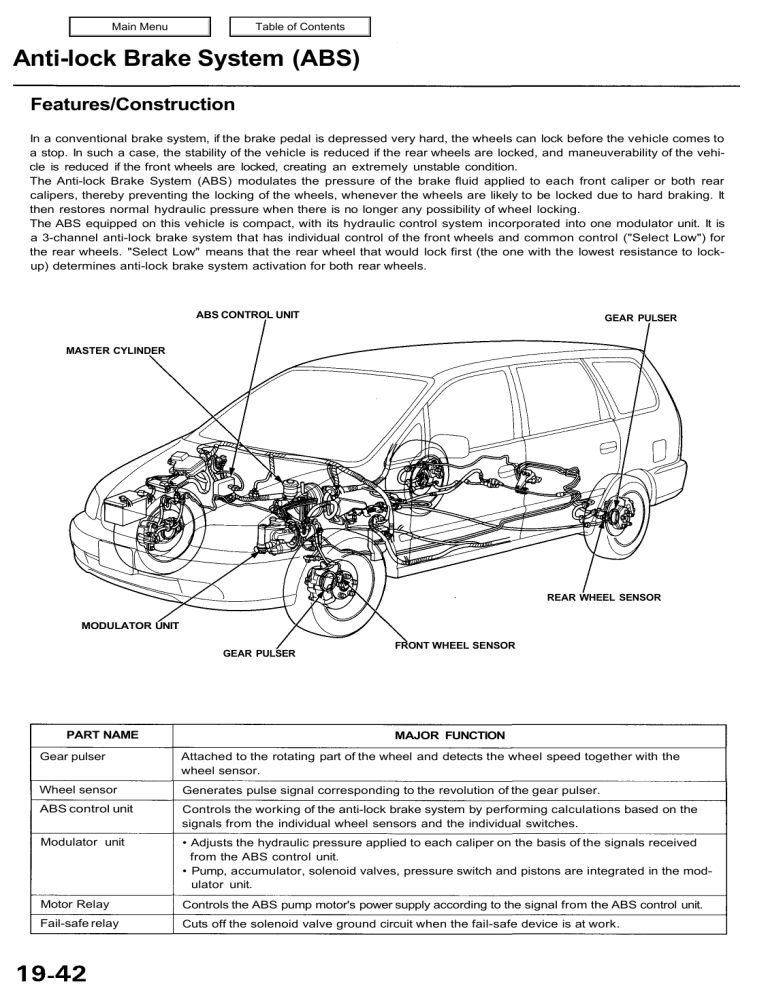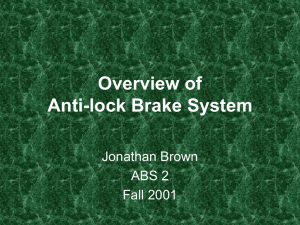Anti-lock Brake System (ABS)

Main Menu Table of Contents
Anti-lock Brake System (ABS)
Features/Construction
In a conventional brake system, if the brake pedal is depressed very hard, the wheels can lock before the vehicle comes to a stop. In such a case, the stability of the vehicle is reduced if the rear wheels are locked, and maneuverability of the vehicle is reduced if the front wheels are locked, creating an extremely unstable condition.
The Anti-lock Brake System (ABS) modulates the pressure of the brake fluid applied to each front caliper or both rear calipers, thereby preventing the locking of the wheels, whenever the wheels are likely to be locked due to hard braking. It then restores normal hydraulic pressure when there is no longer any possibility of wheel locking.
The ABS equipped on this vehicle is compact, with its hydraulic control system incorporated into one modulator unit. It is a 3-channel anti-lock brake system that has individual control of the front wheels and common control ("Select Low") for the rear wheels. "Select Low" means that the rear wheel that would lock first (the one with the lowest resistance to lockup) determines anti-lock brake system activation for both rear wheels.
ABS CONTROL UNIT
GEAR PULSER
MASTER CYLINDER
MODULATOR UNIT
GEAR PULSER
FRONT WHEEL SENSOR
REAR WHEEL SENSOR
PART NAME
Gear pulser
Wheel sensor
ABS control unit
Modulator unit
Motor Relay
Fail-safe relay
MAJOR FUNCTION
Attached to the rotating part of the wheel and detects the wheel speed together with the wheel sensor.
Generates pulse signal corresponding to the revolution of the gear pulser.
Controls the working of the anti-lock brake system by performing calculations based on the signals from the individual wheel sensors and the individual switches.
• Adjusts the hydraulic pressure applied to each caliper on the basis of the signals received from the ABS control unit.
• Pump, accumulator, solenoid valves, pressure switch and pistons are integrated in the modulator unit.
Controls the ABS pump motor's power supply according to the signal from the ABS control unit.
Cuts off the solenoid valve ground circuit when the fail-safe device is at work.
Main Menu Table of Contents
Modulator Unit:
The modulator unit consists of the following sub-units. It adjusts the hydraulic pressure applied to each caliper on the basis of the signals received from the ABS control unit.
• ABS pump and motor: Supplies high-pressure brake fluid to control the ABS operation.
• Accumulator: Stores high-pressure brake fluid in it.
• Pressure switch: Detects the pressure in the accumulator and transmits signals to the ABS control unit.
• Solenoid valves: Switches the ABS high-pressure passage according to the signals from the ABS control unit.
• Pistons and related parts: Receives the high-pressure brake fluid, and controls pressure to the calipers accordingly.
MODULATOR UNIT
Motor and pump:
As the motor rotates, it drives the plunger-type ABS pump and raises the brake fluid pressure to approximately 25 MPa
(250 kgf/cm
2
, 3,600 psi). The eccentric bearing is attached to the motor shaft end; it contacts the plunger of the pump plunger. The motor shaft's rotational motion is transmitted to the reciprocating motion of the pump plunger.
When the plunger is pushed, the brake fluid in the plunger chamber is pressurized and fed to the accumulator, solenoid, and piston, via the check valve. When the pressure in the accumulator exceeds 34 MPa (350 kgf/cm
2
, 5,000 psi), the relief valve opens to release the excess brake fluid pressure to the reservoir, thereby protecting the system.
CHECK VALVE
(OUTLET)
RESERVOIR
RELIEF VALVE
PUMP
CHECK VALVE
(INLET)
MOTOR
To ACCUMULATOR,
SOLENOIDS, PISTONS
PLUNGER
CHAMBER
HIGH-PRESSURE CIRCUIT PLUNGER
ECCENTRIC BEARING
Main Menu Table of Contents
Anti-lock Brake System (ABS)
Features/Construction (cont'd)
Accumulator:
The high-pressure brake fluid discharged from the pump is fed to the solenoids and pistons, but the passages to the solenoids and pistons are normally closed. Consequently, the high-pressure brake fluid accumulates in the accumulator.
The accumulator consists of two chambers separated by a free piston; that is, the fluid chamber where the brake fluid is accumulated, and the chamber filled with highpressure nitrogen gas to maintain the fluid at a given pressure.
When the ABS operates, the constant high-pressure brake fluid in the accumulator is supplied to the piston.
FLUID CHAMBER O-RINGS
GAS CHAMBER
(FILLED WITH NITROGEN GAS)
RELIEF PLUG
FREE PISTON
Pressure switch:
The pressure switch monitors the pressure accumulation in the accumulator. When the pressure in the accumulator rises, the Bourdon tube in the pressure switch deforms outward, which in turn activates the microswitch by the force of the spring attached to the sensing lever. When the pressure in the accumulator drops due to ABS operation, the Bourdon tube moves in the opposite direction, and the micro-switch is eventually turned off.
The ABS control unit detects the fluid pressure in the accumulator by the ON/OFF signals from the pressure switch.
MICRO-SWITCH
BOURDON TUBE
SENSING LEVER
Main Menu Table of Contents
Piston/valve:
The piston/valve assembly consists of the piston, cut valve, and sleeve. There are four piston/valve assemblies in the modulator unit to control the brake fluid pressure to each caliper. The piston/valve assemblies for the rear brakes also serve as proportioning control valves to prevent the rear wheels from locking if the ABS malfunctions or when the ABS is not activated.
Solenoid valves:
The modulator unit opens and closes the inlet and outlet solenoid valves, and shifts the ABS high-pressure passage according to the signals from the ABS control unit. There are three solenoid valve assemblies, each containing an inlet and outlet valve, in the modulator unit; one for each front wheel, and one for both rear wheels. The inlet valves are normally open (open when the coil is not energized), while the outlet valves are normally closed.
To ABS CONTROL
UNIT
To RIGHT-FRONT
WHEEL
To LEFT-FRONT
WHEEL
RELIEF
VALVE
MODULATOR UNIT
RESERVOIR
SOLENOID VALVES (3 SETS)
ACCUMULATOR
PRESSURE
SWITCH
MOTOR
PUMP
PISTON/VALVE
SLEEVE
PISTON
CUT
VALVE
From MASTER
CYLINDER
PRIMARY PISTON
From MASTER
CYLINDER
SECONDARY
PISTON
To LEFT-REAR
WHEEL
To RIGHT-
REAR WHEEL
PUMP MOTOR RELAY
Main Menu Table of Contents
Anti-lock Brake System (ABS)
Features/Construction (cont'd)
Wheel sensor:
The wheel sensor is a contactless type that detects the rotating speed of a wheel. It consists of a permanent magnet and coil. When the gear pulsers attached to the rotating parts of each wheel turn, the magnetic flux around the coil in the wheel sensor alternates, generating voltages with frequency in proportion to wheel rotating speed. These pulses are sent to the ABS control unit, and the ABS control unit identifies the wheel speed.
WHEEL SENSOR
COIL PERMANENT MAGNET at HIGH SPEED at LOW SPEED
GEAR PULSER
GEAR PULSER
ABS control unit:
The ABS control unit consists of a main function, which controls the operation of the anti-lock brake system, and sub-function, which controls the pump motor and "self-diagnosis".
For safety, the main function consists of two systems, and the ABS control unit activates the solenoid valve only when the outputs of the two systems agree with each other.
• The main function section of the ABS control unit performs calculations on the basis of the signals from each wheel sensor, and controls the operation of the anti-lock brake system by activating the solenoid valves in the modulator unit for each front brake and for the two rear brakes. The ABS has individual control of the front wheels and common control ("Select Low") for the rear wheels. "Select Low" means that the rear wheel that would lock first (the one with the lowest resistance to lock-up) determines the ABS activation for both rear wheels.
• The sub-function section has the fail-safe function that monitors the system operation by inputting the brake switch, parking brake switch and pressure switch signals, and stops the anti-lock brake system when it detects an abnormality in the system. It also has a self-diagnosis function and the pump motor control function.
ABS CONTROL UNIT MODULATOR UNIT
WHEEL SENSORS
RIGHT-FRONT WHEEL
LEFT-FRONT WHEEL
RIGHT-REAR WHEEL
LEFT-REAR WHEEL
MAIN FUNCTION
• BASIC ABS
FUNCTION CONTROL
SOLENOID
SOLENOID
SOLENOID
BRAKE SWITCH
SUB-FUNCTION
• SELF - DIAGNOSIS FUNCTION
• FAIL SAFE FUNCTION
• PUMP MOTOR CONTROL
FRONT FAIL - SAFE RELAY
PARKING BRAKE SWITCH REAR FAIL - SAFE RELAY
PRESSURE SWITCH
PUMP MOTOR RELAY PUMP MOTOR
Main Menu Table of Contents
Pump motor control:
The ABS control unit monitors the brake fluid pressure in the accumulator by the pressure switch ON/OFF signals. The
ABS control unit turns the pump on when the pressure in the accumulator drops, and stops the pump when the pressure rises to the specified value.
If the pressure does not reach the specified value after the motor has operated continuously for a specified period, the
ABS control unit stops the motor and activates the ABS indicator light.
Self-diagnosis function:
The self-diagnosis function, provided in the sub-function of the ABS control unit, monitors the main system functions by constantly transmitting the data between the two Central Processing Units (CPUs). When an abnormality is detected, the
ABS control unit turns the ABS indicator light on and stops the ABS, although the basic brake system continues to operate normally.
When the ABS control unit detects an abnormality with the ABS and turns the ABS indicator light on, the diagnostic trouble code (DTC), which shows the problem part or unit, is recorded in the control unit. The DTC can be read by the blinking frequency of the ABS indicator light.
Fail-safe function:
When an abnormality is detected in the ABS control system self-diagnosis, the solenoid operations are suspended by turning off the two fail-safe relays. This disconnects the ground circuits of all the solenoid valves to prevent ABS operation.
Under these conditions, the braking system functions just as an ordinary one.
ABS CONTROL UNIT
SOLENOID VALVE
Fail-safe relay:
The fail-safe relay's terminal side contact is normally open. When there is continuity at the relay coil, the failsafe relay is closed, thereby connecting the ground circuit to the solenoid valve.
BAT
REAR FAIL-SAFE RELAY
FRONT FAIL-SAFE RELAY
ABS indicator light:
The ABS control unit turns the ABS indicator light on when one or more of the following abnormalities are detected. This is only a partial list.
• When the operating time of the motor in the power unit exceeds the specified period.
• When vehicle running time exceeds 30 seconds without releasing the parking brake.
• When absence of speed signals from any of the four wheel sensors is detected.
• When the activation time of all solenoids exceeds a given time, or an open circuit is detected in the solenoid system.
• When solenoid output is not detected in the simulated ABS operation when the engine is started or the vehicle is driven.
To check the indicator light bulb, the light is activated when the ignition switch is first turned on. The light goes off after the engine is started if there is no abnormality in the system.




